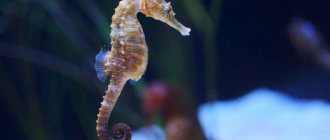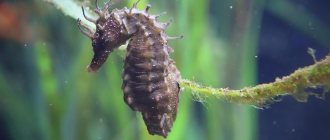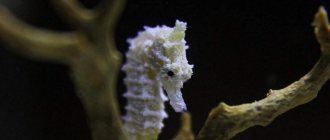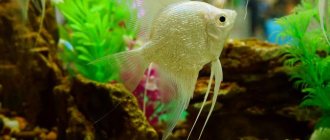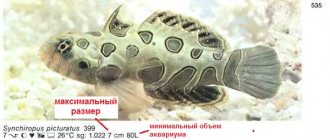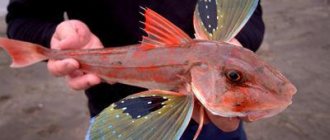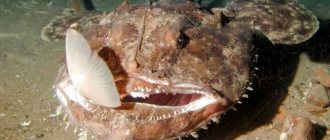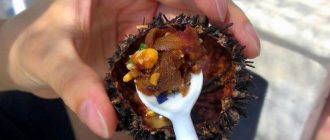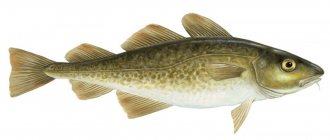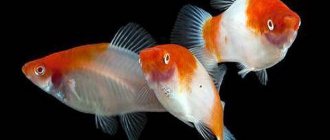13 September69052aquatic inhabitantsseahorsesspined sticklebacks
The seahorse is a small fish, which is a representative of the Spine family from the order Stickleback. Research has shown that the seahorse is a highly modified pipefish. Today the seahorse is a rather rare creature. In this article you will find a description and photo of a seahorse and learn a lot of new and interesting things about this extraordinary creature.
What does a seahorse look like?
The seahorse looks very unusual and its body shape resembles a chess piece of a horse. The seahorse fish has many long bony spines and various leathery projections on its body. Thanks to this body structure, the seahorse appears unnoticed among the algae and remains inaccessible to predators. The seahorse looks amazing, it has small fins, its eyes rotate independently of each other, and its tail is curled into a spiral. The seahorse looks diverse, because it can change the color of its scales.
The seahorse looks small, its size depends on the species and varies from 4 to 25 cm. In the water, the seahorse swims vertically, unlike other fish. This is due to the fact that the seahorse’s swim bladder consists of an abdominal and a head part. The head bladder is larger than the abdominal one, which allows the seahorse to maintain an upright position when swimming.
Now the seahorse is becoming increasingly rare and is on the verge of extinction due to a rapid decline in numbers. There are many reasons for the disappearance of the seahorse. The main one is the destruction by humans of both the fish itself and its habitats. Off the coast of Australia, Thailand, Malaysia and the Philippines, pipits are being caught en masse. The exotic appearance and bizarre body shape are the reason why people began to make gift souvenirs from them. For beauty, the tail is artificially arched and the body is given the shape of the letter “S”, but in nature skates do not look like that.
Another reason that contributes to the decline in the seahorse population is that they are a delicacy. Gourmets highly value the taste of these fish, especially the eyes and liver of seahorses. In a restaurant, the cost of one serving of this dish is $800.
In total, there are about 50 species of seahorses, 30 of which are already listed in the Red Book. Luckily, seahorses are very fertile and can produce over a thousand young at a time, keeping the seahorses from going extinct. Seahorses are bred in captivity, but this fish is very demanding to keep. One of the most extravagant seahorses is the rag-picker seahorse, which you can see in the photo below.
General information
Since the animal is considered a highly modified species of needle fish, it is classified in the order Needlefish . The unusual body of the skate really resembles a chess piece. Perhaps this was the reason to give the animal such a name.
In its natural environment, the seahorse can be found in subtropical and tropical waters around the world. Salty and as clean water as possible is the best condition for his comfortable living. The size of the seahorse is small and ranges from 2 to 30−32 cm. It is quite rare to find individuals that reach 35 cm in length.
There are many theories about where the seahorse lives, as it has been seen in different parts of the world. Most often the animal can be found in water bodies of Australia, sometimes England. Sometimes individual species are found in the Azov and Black Seas. It prefers to stay close to the bottom and uses algae as cover, camouflaging itself in their thickets and changing color according to the color they are painted in.
The seahorse prefers to be at the bottom of the reservoir and hide in the algae
The body of the fish is covered with a very hard and bony shell , which protects from the negative effects of the environment. Often the body has spines of different lengths and shapes, some are covered with long ribbon-like processes of different colors. Surprisingly, this fish has no scales. A special feature of the structure will be the head, since it is very firmly attached to the body and does not rotate. If the horse wants to look back, it turns its whole body or bulges its eyes.
Each eye moves separately from the other. This feature is also inherent in chameleons, which can rotate each eye separately in a circle. There is some debate about how long seahorses live, as they usually live up to 4 years, but in some cases you can find representatives who live up to 6 years.
Another feature of the fish is its vertical position in the water. This is possible due to the fact that the swim bladder is divided into two sections by a thin septum and allows it to maintain a vertical position.
Where does the seahorse live?
The seahorse lives in tropical and subtropical seas. The seahorse fish lives mainly at shallow depths or near the shore and leads a sedentary lifestyle. The seahorse lives in dense thickets of algae and other marine vegetation. It attaches itself to plant stems or corals with its flexible tail, remaining almost invisible due to its body covered with various projections and spines.
The seahorse fish changes body color to completely blend in with its environment. In this way, the seahorse successfully camouflages itself not only from predators, but also while foraging for food. The seahorse is very bony, so few people want to eat it. The main hunter of the seahorse is the large land crab. The seahorse can travel long distances. To do this, it attaches its tail to the fins of various fish and hangs on them until the “free taxi” swims into the algae thickets.
Humans are a big threat to them
The hard shell makes seahorses quite difficult for other fish to digest, so they have virtually no natural predators. Apart from crustaceans, which can pluck them with their sharp pincers, humans are probably one of the most serious threats to this species.
Seahorses most often live in shallow waters close to the coast, so human activities such as pollution, fishing and industrial development threaten their numbers. They are also often caught for use as aquarium pets and in traditional Asian medicine. According to scientists, more than 150 million seahorses are captured from the wild each year for use in traditional medicine.
Seahorses born in the wild usually do not do well in home aquariums. About 1 million are taken from the wild each year for the pet trade, and fewer than a thousand are thought to survive beyond six weeks.
What do seahorses eat?
Seahorses eat crustaceans and shrimp. Seahorses eat very interestingly. The tubular stigma, like a pipette, draws prey into the mouth along with water. Seahorses eat quite a lot and hunt almost the whole day, taking short breaks of a couple of hours.
Seahorses eat about 3 thousand planktonic crustaceans per day. But seahorses eat almost any food, as long as it does not exceed the size of their mouth. The seahorse fish is a hunter. With its flexible tail, the seahorse clings to the algae and remains motionless until the prey is in the required proximity to the head. After which the seahorse absorbs water along with food.
Their goal is to eat constantly
The structure of the seahorse's digestive system is unique because they do not have teeth or even a stomach like other sea creatures. Because of this, the digestive process proceeds with extraordinary speed, forcing animals to constantly feed on carnivorous food from tiny fish and planktonic copepods.
Don't let their small size fool you: seahorses can eat up to 3,000 plankton and small crustaceans in a single day, sucking them up with their tubular snouts from up to three centimeters away. Their elongated snout allows them to penetrate tiny cracks. It can also expand and contract depending on the size of the food it absorbs.
How do seahorses reproduce?
Seahorses reproduce in a rather unusual way, because their young are carried by the male. Seahorses often have monogamous pairs. The mating season of seahorses is an amazing sight. A couple who are about to enter into a marriage union are held together by their tails and dance in the water. During the dance, the skates press against each other, after which the male opens a special pocket in the abdominal area, into which the female throws eggs. Subsequently, the male bears offspring for a month.
Seahorses reproduce quite often and produce large offspring. A seahorse gives birth to one thousand or more young at a time. The fry are born an absolute copy of the adults, only very tiny. The babies that are born are left to their own devices. In nature, a seahorse lives for about 4-5 years.
If you liked this article and you like to read about animals, subscribe to site updates to be the first to receive the latest and most interesting articles about animals.
Don't forget to share with your friends!
The burden of bearing fruit falls on the shoulders of males
Females don't have to worry when it comes to pregnancy and childbirth. Perhaps one of the most distinctive features of the family Syngnathidae (which includes both seahorses and their cousins, pipefish and sea dragons) is that males, not females, bear the burden of pregnancy.
After an intricate courtship dance during the reproductive cycle, females place their eggs in an oviduct in the male's body, which is located in what is called a brood pouch. The male fertilizes the laid eggs from the inside. After this, the males settle down in a resting area for the duration of pregnancy, which can last up to several weeks.
When the time finally comes for the fry to be born, the male experiences violent spasms that push the young out of his pouch. Up to 1,000 young seahorses can be born at one time. Scientists estimate that only about 0.5% of the offspring will survive to become reproducing adults.
Origin of the species and description
Photo: Seahorse
Seahorses belong to the genus of ray-finned fish from the order Acidaceae. Research conducted on seahorses has shown that seahorses are a highly modified subspecies of pipefish. Like needlefish, seahorses have an elongated body shape, a unique structure of the oral cavity, and a long, mobile tail. Not many remains of seahorses have been found - the earliest date back to the Pliocene, and the separation of pipefish and seahorses occurred in the Oligocene.
Video: Seahorse
The reasons are not precisely established, but the following stand out:
- the formation of multiple shallow waters, where fish often swam as vertically as possible;
- the spread of numerous algae and the occurrence of currents. Thus, the fish had a need to develop the grasping functions of the tail.
There are colorful varieties of seahorses that are not unanimously classified as this species by all scientists.
Some of the most colorful seahorses are:
- pipefish. In appearance it resembles a tiny seahorse with a very elongated thin body;
- the spiny seahorse has strong long spines all over its body;
- sea dragons, especially leafy ones. They have a characteristic camouflage shape, as if completely covered with leaves and algae shoots;
- the dwarf seahorse is the smallest representative of seahorses, measuring barely more than 2 cm;
- The Black Sea pipit is a species that does not have spines.
Reproduction
Among all the unusual things, reproduction occupies a leading position. The fact is that it is customary for men to bear baby skates. And the process of conception itself is very strange.
During the mating season, the fish split into pairs and circle around each other, performing a kind of ritual dance. Afterwards, their tails are tightly intertwined and the female places the eggs in the father’s pouch, where they are fertilized and develop. The seahorse woman disappears safely, and the care falls on the man’s shoulders.
There is no salt water in the bursa fluid, as salt could harm the eggs. But as they grow, the water begins to more and more resemble the composition of the sea. Like little kangaroos, the eggs live under their father’s belly for two whole months.
Sharing with other fish
Seahorses are peaceful among their subspecies, however, they can be aggressive towards representatives of other families. It is best to keep exotic fish without “neighbors”.
Still, there are some fish that can be added to the spiny fish. These include blenny fish, gobies, snails, and small species of hermit crabs. These inhabitants are united by the process of searching and consuming food. These are bottom-dwelling creatures that do not rise into the water column to find food.
Before purchasing a seahorse, you should carefully read the information about it. Only proper care can ensure a painless life for the needle-shaped ones.
